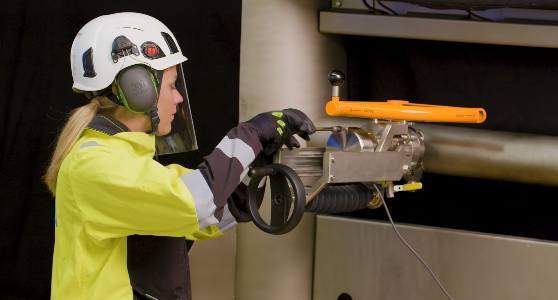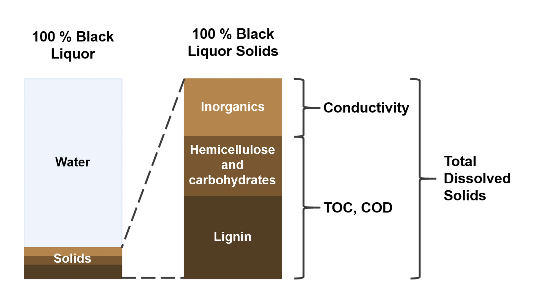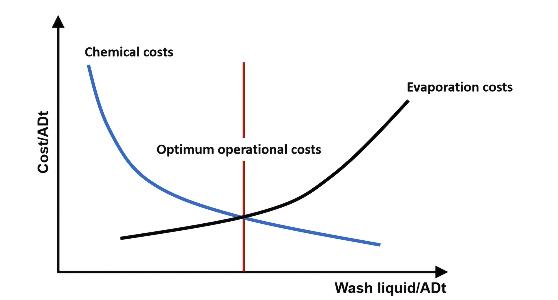
Brought to you by Vaisala
Monitoring brown stock washing to boost pulp production efficiency and precision

November 8, 2023 in Features
By Keijo Pyörälä, Vaisala Business Development Manager, Liquid Measurements
 The Vaisala Polaris™ PR53SD measures TDS continuously and in-line for real-time analysis. Photo courtesy of Vaisala
The Vaisala Polaris™ PR53SD measures TDS continuously and in-line for real-time analysis. Photo courtesy of Vaisala Canada’s pulp and paper industry remains a significant economic driver in the face of extensive changes since the turn of the century. As of 2021, the industry accounted for nearly $17 billion in exports while directly and indirectly employing nearly 600,000 workers nationwide. Between shifting market forces, technological advances and evolving sustainability commitments, however, the industry’s landscape is rapidly changing.
In pulp and paper, optimizing processes like brown stock washing, or BSW, is the key to maintaining efficiency and achieving high-quality pulp production through this evolution. But evaluating the washing process is complex in practice.
Studies have shown that kraft pulp processing is only economically viable if the BSW stage operates optimally. Online monitoring of total dissolved solids (TDS) using a process refractometer unlocks cleaner and better quality pulp, reduced environmental impact and considerable pulp mill cost savings.
Why should pulp mills optimize brown stock washing?
Brown stock washing happens early in the pulping process, and its efficiency impacts the pulp mill’s economic performance at various stages.
By removing dissolved organics and inorganics, effective washing produces cleaner pulp for bleaching and recovery of pulping chemicals. Chemical recovery positively impacts the economics of the process, but recovering black liquor solids is also important.
Organic compounds used for energy production are recovered to reduce bleaching chemical use. Recovered inorganic compounds are used for regeneration of cooking chemicals. Consequently, the more inorganics lost with the pulp, the greater the cost requirement for pulp makeup chemicals in the recovery system.
As pulp mills strive to deliver a cleaner and more sustainable product, proper BSW reduces reagent consumption to improve oxygen delignification and subsequent bleaching stages. Given its significant cumulative positive economic impact, pulp mills cannot afford to overlook BSW optimization. However, the washing process is complicated, with many variables impacting the final product.
Total dissolved solids: a parameter for real wash loss
Traditionally, two main parameters describe the performance of washing efficiency:
- Wash loss, or the amount of washable compounds in the pulp suspension that could have been removed in washing.
- Dilution factor, which represents the net amount of water that is added during washing.
While mass balances, the displacement ratio and the Norden efficiency factor are useful control tools, calculating these variables can be difficult due to the lack of data and need for robust instruments capable of taking reliable inline wash loss measurements. To determine the actual wash loss, the parameter should account for both inorganics and organics and be continuous, integrated into the control system and reliable under even the most demanding process conditions. Enter total dissolved solids.

Black liquor composition. Photo courtesy of Vaisala.
TDS takes account of both the inorganic and organic fractions, thus quantifying all washable solids. By monitoring TDS in line with a process refractometer like the Vaisala Polaris™ PR53SD, pulp mills can better understand the washing process and its efficiency.
Examining the overall economic relationship between pulp mill operating cost and efficiency involves maximizing the BSW solids yield due to its heat value in the recovery boiler and minimizing the dilution factor to reduce steam consumption in the evaporators. Evaporators are typically the bottleneck in any pulp mill, so minimizing the water used for washing directly increases evaporator throughput and reduces steam requirements. Additional considerations include the cost of makeup chemicals, effluent treatment, bleach chemical consumption and any evaporator efficiency limitations at the mill.

The overall economic relationship between operating cost and efficiency. Photo courtesy of Vaisala.
The key to optimal BSW is balancing water used in washing and chemicals used in bleaching and employing inline, real-time measurement to provide accurate process data that drives quick responses to potential process changes or disturbances.
Capable of continuously monitoring individual process steps and controlling the whole washing line, the Vaisala Polaris PR53SD Process Refractometer detects TDS changes immediately in the feed and outlet stock lines and the incoming and outgoing filtrate lines. Washing system efficiency can essentially be calculated based on TDS measurements. The ratio of dissolved solids entering the system with the pulp and leaving the system with the filtrate represents the quantity of solids removed.
Monitoring TDS requires measurements at various critical points to ensure a comprehensive understanding of the efficiency and quality throughout the washing process. Typical applications where TDS measurement is invaluable include the following:
- Digester washing zone and blow line, allowing a quick response to process changes and preventing disturbances from carryover into subsequent washing stages.
- Pulp feed to washers, enabling the ability to control the performance of the washing zone in the digester.
- Filtrate lines during the washing stage, where TDS measurements provide better control and help determine the optimal dilution factor, operation consistency and solids concentration in the stream to the recovery boiler.
- Pulp to oxygen delignification by reducing wash loss in the inlet pulp to the reactors, which decreases the amount of alkali consumed in neutralization reactions of the organic acids.
- Pulp discharge to bleaching. Lower wash loss in the outlet pulp improves its quality while decreasing the chemicals required in the bleaching stage.
Whether used to adjust the dilution factor, control and minimize wash loss, monitor dry solids content to evaporation, ensure that the process operates within the mill’s evaporation capacity or continuously monitor washer performance, TDS measurements can significantly enhance washing efficiency.
Elevating pulp production toward a cleaner, more profitable future
Allowing for continuous control of the washing process, real-time inline TDS measurements empower decision-makers to improve the pulp quality while realizing impressive cost savings. The improved pulp quality reduces the consumption of reagents in oxygen delignification and bleaching and leads to fewer harmful organic compounds used during bleaching.
From enhanced recovery of cooking chemicals to optimized energy use to better mechanical performance of the washers, the benefits of inline measurement and process control in BSW empower pulp mills seeking to enhance their overall production process efficiencies to strategically move toward sustainability, efficiency and profitability. An optimized washing line has a positive impact on the economics of the pulping process as well as the environmental load of the mill.